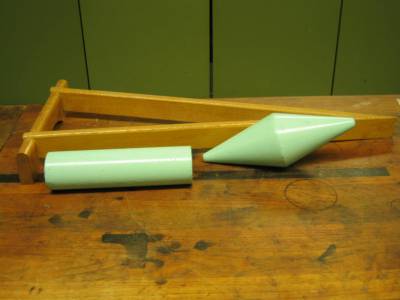User Tools
Table of Contents
Rolling Up/down An Inclined Track
Description
Consists of a wooden v-shaped track set on an incline, and two wooden rollers painted light blue; a cylinder and a double-cone.
Purpose
Illustrate that rolling downhill isn't really about the slope of the incline, but instead related to the loss of potential energy. In other words, 'downhill' is the direction that decreases the height of the center of mass.
Apparatus
- V-shaped track
- Double-conical roller
- Cylindrical roller
Setup
The cylinder when placed at the top of the track rolls to the bottom as its center of mass moves toward its point of lowest potential energy. The double cone when placed at the bottom of the track has its center of mass above the track. Therefore the cone moves uphill and as the track widens, the cone's center of mass is lowered until it can no longer move uphill. This happens because the 'effective radius' of the double cone goes down as the space between the sides of the track widens, which is more than enough to cancel the incline of the slope.
Notes
The exact incline of the slope may need to be adjusted a bit to produce the desired effect, particularly if the surface you're showing this on isn't exactly flat.
Demo room information
| Location | N1 |
| Maker | Unknown |
| Current State | Working |

